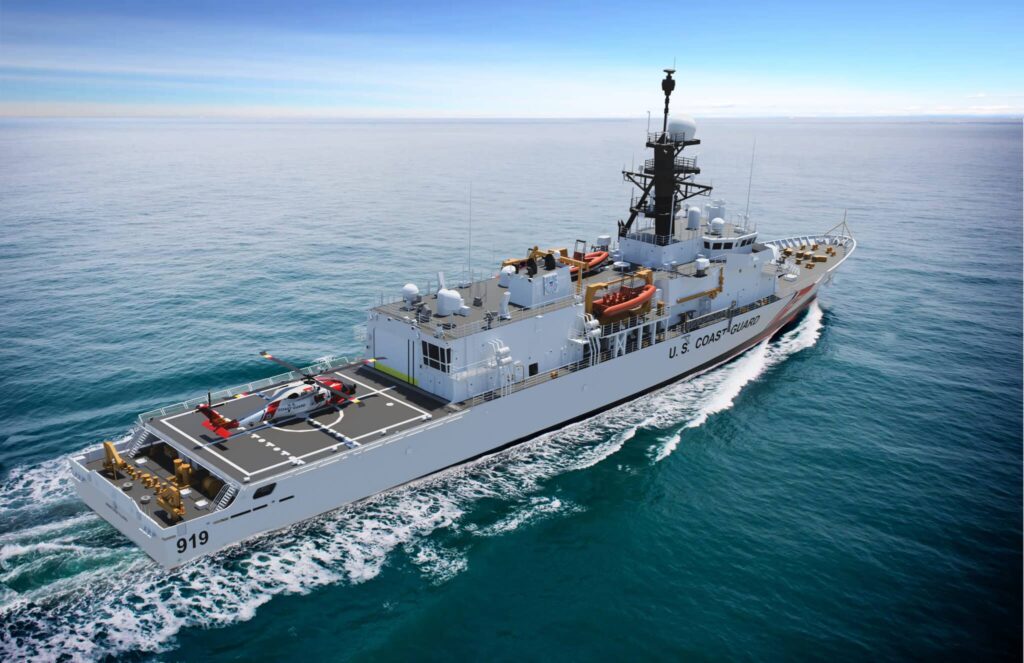
The U.S. Coast Guard has exercised $314 million in contract options with Austal USA, advancing its Offshore Patrol Cutter (OPC) program. This decision, announced recently, allows Austal USA to procure long lead-time materials for the construction of its fourth, fifth, and sixth OPCs. These funds also cover logistics supply items for two additional cutters, marking a significant step in the $3.3 billion initiative.
The original contract, awarded in June 2022, encompasses the detailed design and construction of up to 11 OPCs. So far, two of these vessels have been commissioned to Austal USA, which underscores the strategic importance of this latest contract extension.
In a statement, Austal USA President Michelle Kruger expressed enthusiasm about the contract options, stating, “We are pleased to receive these contract options for long lead-time materials in support of the U.S. Coast Guard’s OPC program. These early awards speak to the strong partnership that has developed between the Coast Guard and Austal USA teams. We look forward to continuing to strengthen our partnership and deliver these much-needed cutters.”
Strategic Importance of the Offshore Patrol Cutter Program
The Offshore Patrol Cutter is a critical component of the U.S. Coast Guard’s strategy to bolster national security. These 360-foot vessels are designed to operate beyond 12 nautical miles from shore, fulfilling a variety of missions that include law enforcement, drug and migrant interdiction, and search and rescue operations.
With a range of 10,200 nautical miles at 14 knots and a 60-day endurance period, each OPC is capable of deploying independently or as part of task groups. The cutters serve as mobile command and control platforms for surge operations, such as hurricane response and mass migration incidents. Furthermore, they play a vital role in supporting Arctic objectives, regulating and protecting emerging commerce and energy exploration in Alaska.
Construction and Future Prospects
Construction of Austal USA’s first OPC, the Pickering (WMSMS 919), is progressing with the keel laying scheduled for December. Meanwhile, work on the second cutter, Icarus (WMSMS 920), commenced in early August. These developments highlight the ongoing commitment to enhancing the Coast Guard’s offshore capabilities.
The move represents a significant investment in the future of the Coast Guard’s operational readiness. By expanding its fleet of OPCs, the Coast Guard aims to maintain a robust offshore presence, ensuring the protection of national interests in diverse maritime environments.
Expert Opinions and Historical Context
According to maritime defense analyst John Reynolds, “The expansion of the OPC program is not just about increasing numbers; it’s about enhancing capabilities. These cutters are vital for maintaining a strong maritime presence and responding to a wide range of security challenges.”
Historically, the Coast Guard has relied on a mix of vessels to fulfill its diverse missions. The introduction of the OPCs marks a significant evolution in its fleet composition, offering enhanced endurance and operational flexibility compared to older classes of cutters.
“With the new OPCs, the Coast Guard is better equipped to tackle modern maritime threats and support national security objectives,” Reynolds added.
Implications and Future Developments
The exercise of these contract options signals a continued investment in maritime security infrastructure. As construction progresses, the Coast Guard is poised to enhance its operational capabilities, ensuring readiness for future challenges.
Looking ahead, the successful deployment of these cutters will likely influence future procurement strategies and operational planning. The Coast Guard’s commitment to modernizing its fleet is expected to have far-reaching implications for national security and maritime governance.
As the U.S. Coast Guard and Austal USA continue their collaboration, the focus will remain on delivering these advanced vessels on schedule, ensuring they meet the evolving demands of maritime security operations.







